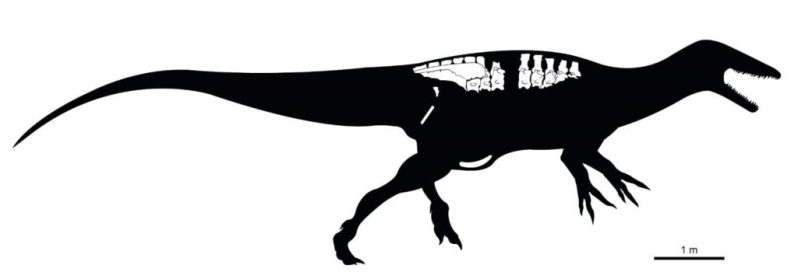
Early-late Carnian (Late Triassic) palaeogeographic reconstruction showing some of the main vertebrate-bearing units (From Bernardi et al. 2018)
Dinosaurs likely originated in the Early to Middle Triassic. The Manda beds of Tanzania yielded the remains of the possible oldest dinosaur, Nyasasaurus parringtoni, and Asilisaurus, a silesaurid (the immediate sister-group to Dinosauria). However the oldest well-dated identified dinosaurs are from the late Carnian of the lower Ischigualasto Formation in northwestern Argentina, dated from 231.4 Ma to 225.9 Ma. The presence of dinosaurs, such as Panphagia, Eoraptor, and Herrerasaurus support the argument that Dinosauria originated during the Ladinian or earlier and that they were already well diversified in the early Carnian. Similarly, the Santa Maria and Caturrita formations in southern Brazil preserve basal dinosauromorphs, basal saurischians, and early sauropodomorphs. In North America, the oldest dated occurrences of vertebrate assemblages with dinosaurs are from the Chinle Formation. Two further early dinosaur-bearing formations, are the lower (and upper) Maleri Formation of India and the Pebbly Arkose Formation of Zimbabwe. These skeletal records of early dinosaurs document a time when they were not numerically abundant, and they were still of modest body size (Eoraptor had a slender body with an estimated weight of about 10 kilograms).
Trace fossil evidence suggests that the first dinosaur dispersal in the eastern Pangaea is synchronous with an important climate-change event named the “Carnian Pluvial Episode” (CPE) or “Wet Intermezzo”, dated to 234–232 Ma.

Skeleton of Eoraptor lunensis (PVSJ 512) in left lateral view. Scale bar equals 10 cm. From Sereno et al., 2013.
The Late Triassic is marked by a return to the hothouse condition of the Early Triassic, with two greenhouse crisis that may also have played a role in mass extinctions. Isotopic records suggest a global carbon cycle perturbation during the Carnian that was coincident with complex environmental changes and biotic turnover.
The CPE is often described as a shift from arid to more humid conditions (global warming, ocean acidification, mega-monsoonal conditions, and a generalised increase in rainfall). In the marine sedimentary basins of the Tethys realm, an abrupt change of carbonate factories and the establishment of anoxic conditions mark the beginning of the climate change. The CPE also marks the first massive appearance of calcareous nannoplankton, while groups, like bryozoans and crinoids, show a sharp decline during this event.

Palynological association from the Heiligkreuz Formation provide information on palynostratigraphy and palaeoclimate during the last part of the Carnian Pluvial Event (CPE). From Roghi et al., 2014
On land, palaeobotanical evidence shows a shift of floral associations of towards elements more adapted to humid conditions (the palynological record across the CPE suggest at least 3–4 discrete humid pulses). Several families and orders make their first appearance during the Carnian: bennettitaleans, modern ferns, and conifer families (Pinaceae, Araucariaceae, Cheirolepidaceae). The oldest biological inclusions found preserved in amber also come from the Carnian; and key herbivorous groups such as dicynodonts and rhynchosaurs, which had represented 50% or more of faunas, disappeared, and their places were taken by dinosaurs.
Despite the global significance of the CPE, the trigger of the environmental change is still disputed. Volcanic emissions from the Wrangellia igneous province and the dissociation of methane clathrates could be linked to the CPE. It seems that the combination of that events would be the most likely explanation for the substantial shift of the C isotope excursion observed at the CPE.
References:
Massimo Bernardi et al. Dinosaur diversification linked with the Carnian Pluvial Episode, Nature Communications (2018). DOI: 10.1038/s41467-018-03996-1
Miller et al., Astronomical age constraints and extinction mechanisms of the Late Triassic Carnian crisis, Scientific Reports | 7: 2557 | (2017) DOI:10.1038/s41598-017-02817-7
Rogui et al. Field trip to Permo-Triassic Palaeobotanical and Palynological sites of the Southern Alps, Geo.Alp. 11. 29-84. (2014)
(2013) Osteology of Eoraptor lunensis (Dinosauria, Sauropodomorpha),Journal of Vertebrate Paleontology, 32:sup1, 83-179, DOI: 10.1080/02724634.2013.820113



